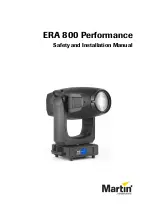
NEAX2400 IPX Feature Programming Manual
Page 430
NDA-24297, Issue 1
L-5
Least Cost Routing - 3/6-Digit
Programming (cont’d)
OPR No. (OPR) - Outgoing Pattern Route. The number referenced in AFRS, consisting of a series of
routes to be chosen based on number dialed.
Route Advance Number (RA) - The order in which a route will be selected (0-7). For the above
example; RA0 = Band 1, RA1 = Band 5, RA2 = DDD.
Route Advance End Display (E) - The last route in the route advance group is indicated with data “0”.
All others are indicated with data “1”.
Route Number (RT) - The physical Route Number to be selected as programmed in ARTD.
Skip Digits (SKIP) - The digits to be skipped when translating the dialed digits in AFRS. (If ARTD is
assigned as shown [see CDN 13:AC], always assign “1”, at a minimum, to skip the LCR (S) access
code.)
Pattern Number Location (PNL) - If digits are to be added after translating the dialed digits in AFRS,
assign a PNL (1-15). The digits to be added are programmed to the respective PNLs in the AADC
command. If no digits are to be added, PNL = 0 should be assigned.
Overflow Tone (OVFT) - Assign if a tone is wanted for the Last Choice Route. If so, assign data “1”
for DDD.
Priority Restriction Class (PRSC) - Refer to PRIORITY RESTRICTION CLASS in the EPN Feature
and Specification. If this is required, assign PRSC here, using classes 1-15. For all other systems,
always assign PRSC as data “0”.
STEP 12: AADC
- If additional digits are required, assign the digits of a Pattern Number Location (PNL) here.
For additional digits totaling 24, use PNL 1-255. For EPN programs, PNL has been expanded to 1-999.
STEP 13: ASDC
- If 6-digit translation is required, whereby both Area and Office codes must be examined, this
command must be used. If no assignment is made in this command, all NXXs are allowed. After an
NXX is assigned (either as allowed or denied), all other NXXs will subsequently be denied. The table
becomes an allow table. Program each office code to be allowed with the EFFECT = 1.
The number of NXXs to be either allowed or denied will determine the method of programming used.
For example, if it is determined that only 555 is to be restricted from a Special Common Carrier, it is
more desirable to allow all NXXs and restrict only this NXX. The method would be as follows:
To create a deny table assign the following:
Step a): OFLG: ALL
EFFECT: 1
Step a, allows all NXXs, thus making a deny table. Program each office code with the EFFECT = 0.
Step b): OFLG: INPUT
OFFICE: 555
EFFECT: 0 (Step b restricts 555 only)
Program the kind of route as PFX (Prefix, Foreign Exchange, FX) or as SCC (Special Common
Carrier).
Choose TDPTN, Time of Day Pattern. Go to ATCP.
Choose the OPR number this 6-digit table will serve.
Choose the RA (Route Advance) Number to specify the route in the OPR.
When assigning for PFX, each NXX is assigned as the following:*
EFFECT:
0 = Does not require a prefix
EFFECT:
1 = Allow, with 1 + dialing
Note
EFFECT:
2 = Only for display
Содержание NEAX2400 ICS
Страница 1: ...OCTOBER 2000 NEC America Inc NDA 24297 ISSUE 1 STOCK 200775 Feature Programming Manual ...
Страница 43: ...NEAX2400 IPX Feature Programming Manual Page xxvi NDA 24297 Issue 1 This page is for your notes ...
Страница 690: ...NEAX2400 IPX Feature Programming Manual NDA 24297 Issue 1 Page 647 Splitting S 4 Programming No programming is required ...
Страница 1089: ...NEAX2400 IPX Feature Programming Manual Page 1046 NDA 24297 Issue 1 This page is for your notes ...
















































